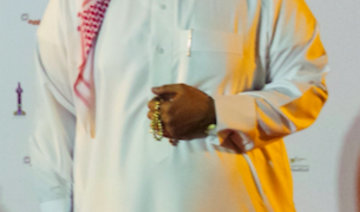DUBAI: With daring filmmakers, untold stories and entertainment-starved young people, Saudi Arabia has all the makings of a local movie industry — except for theaters.
As the traditionally austere Kingdom cautiously embraces more forms of entertainment, local filmmakers are exploring a new frontier in Saudi art, using the Internet to screen films and pushing boundaries of expression — often with surprise backing from top royals.
“Saudi Arabia is the future of filmmaking in the Gulf,” said Butheina Kazim, co-founder of Dubai’s independent cinema platform “Cinema Akil,” pointing to a crop of Saudi films that have emerged in recent years.
Kazim screened three Saudi short films to audiences in Dubai last month, including one called “Wasati”, or moderate in Arabic. The movie is based on a real-life event that took place in the mid-1990s when a group of ultraconservatives rushed the stage during a play in Saudi Arabia and shut it down. The incident dampened theater in Saudi Arabia for years.
The film by Ali Kalthami was screened in Los Angeles last year, and was shown for one night in June at Riyadh’s Al Yamamah University — in the same theater where the play was shut down two decades ago.
One of Saudi Arabia’s most prominent film pioneers, Kalthami is co-founder of C3 Films and Telfaz11, a popular YouTube channel that has amassed more than 1 billion views since it was launched in 2011.
His movie “Wasati” was one of several Saudi shorts produced last year with funding from the King Abdulaziz Center for World Culture, an initiative named after the founder of the kingdom by Saudi Arabia’s state-oil company Aramco. Kalthami said it was the first time he would ever received funding for a film from a state-linked entity.
“I think because of the history we made online... they trusted we could tell wonderful stories, human stories in Saudi,” he said.
By using the Internet to show films, Telfaz11 and other Saudi production houses have managed to circumvent traditional distribution channels and make do without cinemas. Even so, Saudi filmmakers have to contend with how to tell their stories within the bounds of the kingdom’s ultraconservative mores and its limits on free speech.
It was not always like this. There used to be movie theaters across Saudi Arabia from the 1960s through the 1980s, until religious hard-liners were given greater sway over public life. In the years that followed, Saudis could rent movies from video stores, though scenes of lovemaking and cursing were edited out. Saudis also had access to movies on satellite channels.
Nowadays, Saudis can stream movies online — where Telfaz11 has partnered with YouTube.
Some of the local films being produced are purely for entertainment, while others wade into the myriad everyday challenges people in Saudi Arabia face.
The film “Wadjda” made history in 2013 by becoming the first Academy Award entry for Saudi Arabia, though it was not nominated for the Oscars. The movie follows the story of a 10-year-old girl who dreams of having a bicycle just like the boys in her ultraconservative neighborhood, where men and women are strictly segregated and where boys and girls attend separate schools. The film was written and directed by Saudi female director Haifaa Al-Mansour, who shot the film entirely in the kingdom.
Saudi Arabia is vying again this year for an Oscar in the foreign-language film category. The film “Barakah Meets Barakah”, by director Mahmoud Sabbagh, made its premiere at the Berlin International Film Festival in February. The movie, which has been called the kingdom’s first romantic comedy, tells the story of a civil servant who falls for a Saudi girl whose Instagram posts have made her a local celebrity.
Though four years apart, the two films tackle the issue of gender segregation in Saudi Arabia, which remains strictly enforced.
The emergence of a Saudi film scene is happening as the kingdom begins to loosen the reins on fun and entertainment after nearly two decades without cinemas or concerts.
Saudi Arabia’s 31-year-old heir to throne, Mohammed bin Salman, is set to inherit a nation where more than half of the population is under 25, and most are active on social media, where they can access the world beyond the reach of state censors.
The crown prince is behind an ambitious blueprint to transform Saudi Arabia’s economy and society. He wants to encourage Saudis to spend more of their money locally, including doubling what Saudi families spend on entertainment in the kingdom.
While Saudi Arabia’s influential clerics and many citizens consider Western-style entertainment sinful, the prince’s backing means there could soon be cinemas in the kingdom. Prince Mohammed’s nonprofit, MiSK, sponsored a screening in August of an Arabic 3D action film in the capital, Riyadh. There have been other similar screenings in the coastal city of Jiddah.
The government has also backed a Saudi film festival that is taken place for the past few years in the eastern city of Dhahran. This year, some 60 Saudi films were screened.
After watching the Saudi shorts in Dubai’s Cinema Akil and meeting the filmmakers, aspiring filmmaker Lamia Al-Shwwier, who is just graduated with a master’s degree from the Los Angeles campus of the New York Film Academy, said she felt confident about the prospects of a Saudi film industry.
“We have so many incredible stories to tell, whether they are stories of success or challenge. Our society is rich in stories and ideas,” she said.
Saudi filmmakers build audiences without cinemas
Saudi filmmakers build audiences without cinemas

Harry Styles announces first album in 4 years, ‘Kiss All the Time. Disco, Occasionally’

- It follows the critically acclaimed synth pop “Harry’s House,” which earned the former One Direction star album of the year at the 2023 Grammy Awards
- “Kiss All the Time. Disco, Occasionally” will contain 12 tracks and is executive produced by Kid Harpoon
NEW YORK: In this world, it’s just him: Harry Styles has announced that his long-awaited, fourth studio album will arrive this spring.
Titled “Kiss All the Time. Disco, Occasionally” and out March 6, the album is Styles’ first full-length project in four years. It follows the 2022, critically acclaimed synth pop record “Harry’s House,” which earned the former One Direction star the top prize of album of the year at the 2023 Grammy Awards.
In a review, The Associated Press celebrated “Harry’s House” for showcasing “a breadth of style that matches the album’s emotional range.”
On Instagram, Styles’ shared the cover artwork for “Kiss All the Time. Disco, Occasionally,” which features the 31-year-old artist in a T-shirt and jeans at night, standing underneath a shimmering disco ball hung outside.
According to a press release, “Kiss All the Time. Disco, Occasionally” will contain 12 tracks and is executive produced by Kid Harpoon. The British songwriter and producer has been a close collaborator of Styles’ since the beginning of his solo career, working on all of his albums since the singer’s 2017 self-titled debut.
“Kiss All the Time. Disco, Occasionally” is now available for preorder.
It is also Styles’ first project since his former One Direction bandmate Liam Payne died in 2024 after falling from a hotel balcony in Argentina.














